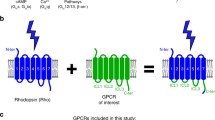Abstract
Multiple reports have described the presence of functional G protein-coupled receptors (GPCRs) in the perinuclear/nuclear membranes of many cell types where they are able to modulate nuclear Ca2+ influx, transcription initiation, and gene expression. Because GPCRs represent “some of the most promising targets for drug development” a better understanding of their roles, not only at the cell membrane but also at the nuclear level, in healthy and disease states, will certainly generate new avenues for therapeutic intervention. The photo-triggered release of biologically active compounds has been regarded as one of the most effective methods for inducing an in vitro-controlled biochemical or physiological response. Here, we describe various methodologies and alternatives related to the conception of inert biologically active peptides through the incorporation of photo-triggered groups at key positions of the native peptide sequence.
Access this chapter
Tax calculation will be finalised at checkout
Purchases are for personal use only
Similar content being viewed by others
References
Chatenet D, Nguyen TT, Letourneau M, Fournier A (2012) Update on the urotensinergic system: new trends in receptor localization, activation, and drug design. Front Endocrinol (Lausanne) 3:1
Tadevosyan A, Vaniotis G, Allen BG et al (2012) G protein-coupled receptor signalling in the cardiac nuclear membrane: evidence and possible roles in physiological and pathophysiological function. J Physiol 590:1313–1330
Gjerstad J, Valen EC, Trotier D, Doving K (2003) Photolysis of caged inositol 1,4,5-trisphosphate induces action potentials in frog vomeronasal microvillar receptor neurones. Neuroscience 119:193–200
Callaway EM, Katz LC (1993) Photostimulation using caged glutamate reveals functional circuitry in living brain slices. Proc Natl Acad Sci U S A 90:7661–7665
Bourgault S, Letourneau M, Fournier A (2005) Development and pharmacological characterization of “caged” urotensin II analogs. Peptides 26:1475–1480
Bourgault S, Letourneau M, Fournier A (2007) Development of photolabile caged analogs of endothelin-1. Peptides 28:1074–1082
Lee HM, Larson DR, Lawrence DS (2009) Illuminating the chemistry of life: design, synthesis, and applications of “caged” and related photoresponsive compounds. ACS Chem Biol 4:409–427
Shigeri Y, Tatsu Y, Yumoto N (2001) Synthesis and application of caged peptides and proteins. Pharmacol Ther 91:85–92
Hruby VJ (2002) Designing peptide receptor agonists and antagonists. Nat Rev Drug Discov 1:847–858
Jamieson AG, Boutard N, Beauregard K et al (2009) Positional scanning for peptide secondary structure by systematic solid-phase synthesis of amino lactam peptides. J Am Chem Soc 131:7917–7927
Tatsu Y, Nishigaki T, Darszon A, Yumoto N (2002) A caged sperm-activating peptide that has a photocleavable protecting group on the backbone amide. FEBS Lett 525:20–24
Taniguchi A, Sohma Y, Kimura M et al (2006) “Click peptide” based on the “o-acyl isopeptide method”: control of A beta1-42 production from a photo-triggered A beta1-42 analogue. J Am Chem Soc 128:696–697
Wood JS, Koszelak M, Liu J, Lawrence DS (1998) A caged protein kinase inhibitor. J Am Chem Soc 120:7145–7146
Kalbag SM, Roeske RW (1975) A photolabile protecting group for histidine. J Am Chem Soc 97:440–441
Pan P, Bayley H (1997) Caged cysteine and thiophosphoryl peptides. FEBS Lett 405:81–85
Ramesh D, Wieboldt R, Niu L et al (1993) Photolysis of a protecting group for the carboxyl function of neurotransmitters within 3 microseconds and with product quantum yield of 0.2. Proc Natl Acad Sci U S A 90:11074–11078
Barlos K, Chatzi O, Gatos D, Stavropoulos G (1991) 2-Chlorotrityl chloride resin. Studies on anchoring of Fmoc-amino acids and peptide cleavage. Int J Pept Protein Res 37:513–520
Author information
Authors and Affiliations
Corresponding authors
Editor information
Editors and Affiliations
Rights and permissions
Copyright information
© 2015 Springer Science+Business Media New York
About this protocol
Cite this protocol
Chatenet, D., Bourgault, S., Fournier, A. (2015). Design and Application of Light-Activated Probes for Cellular Signaling. In: Allen, B., Hébert, T. (eds) Nuclear G-Protein Coupled Receptors. Methods in Molecular Biology, vol 1234. Humana Press, New York, NY. https://doi.org/10.1007/978-1-4939-1755-6_3
Download citation
DOI: https://doi.org/10.1007/978-1-4939-1755-6_3
Published:
Publisher Name: Humana Press, New York, NY
Print ISBN: 978-1-4939-1754-9
Online ISBN: 978-1-4939-1755-6
eBook Packages: Springer Protocols




